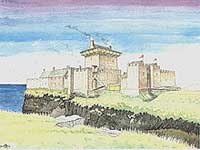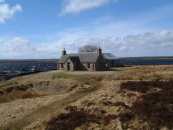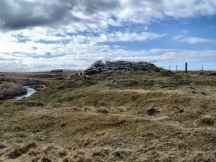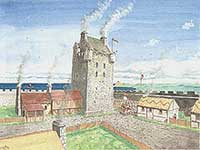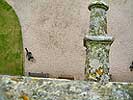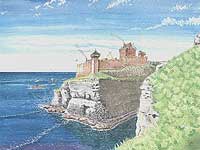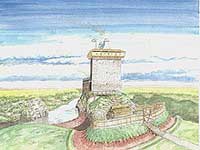|
History Of Caithness Chapter 5 by J T Calder - 1887 Illustrated with Reconstructions By Andrew Spratt Other Material by Robert Richmond This chapter was selected for inclusion as it mentions several of the Caithness Castles Click Here for the whole of the History of Caithness by J T Calder About the beginning of the fourteenth century, Reginald or Ronald Cheyne, a celebrated chieftain, held great sway in Caithness. The Cheynes were, it appears of Norman extraction, and came to Scotland in quest of better fortune, with the Sinclairs and other chiefs who followed the standard of William the Conqueror. The principal residence of the Cheynes was the old castle of Inverugie, in the parish of St Fergus, Aberdeenshire. They became proprietors of the whole of that parish, as well as of other landed estates in the counties of Banff and Moray. In the old statistical account of St. Fergus, mention is made of a Sir Reginald Cheyne, who married a daughter of Cumming of Badenoch. By her he had two sons, Reginald Cheyne, who in 1267 was promoted to the office of Lord chamberlain of Scotland, and Henry Cheyne, who was elected Bishop of Aberdeen in 1281. In the battle of Harlaw, in 1411, was one of the Cheynes, on the side of the Earl of Mar. The leader of the men-at-arms is represented in a ballad as asking counsel at him when they came in sight of the Celtic army under the Lord of the Isles;- ”Noo, what wad
ye do Reginald Cheyne, ”Tho’ they are
twenty thousand men, ”My horse wad
ride through ranks sae rude, But being extremely fond of the chase, he frequently resided in the upper part of the parish of Halkirk, in a castle, or rather hunting lodge, situated at the north corner of Loch More, just at the point where the river of Thurso issues from it.
In this stronghold, Morar-na-Sheamn, or the great Cheyne, as he was styled by the Celtic inhabitants of the district, kept about him a number of retainers, lived in feudal pomp, and chiefly employed his time in hunting, for which he had ample room and verge enough in the highlands of Caithness. Cheyne was
altogether a remarkable man in his day. He was one of the Scottish
chiefs and barons who, in the Parliament held at Arbroath in 1320, drew
up the spirited remonstrance to the Pope on the national independence
of Scotland in church and State. He was also present at the disastrous battle of Halidon Hill in 1333, with Kenneth, Earl of Sutherland. The Earl was slain, and Cheyne taken prisoner by the English, but after a short captivity, he was released, when he returned to Caithness and soon after married a young lady of considerable talent and beauty, a descendant of the old Scandinavian prefects or governors of the district. Tradition has handed down many strange anecdotes of this Nimrod of the North. The following, which is believed to be strictly founded in truth, is one of the most remarkable and interesting. Being the last representative of his family in the male line, he was extremely anxious to have an heir to inherit his large property. The first child which his lady had was a daughter. This disappointment exasperated him so second child, which was also a daughter was preserved in the same manner. After this she bore no more children. The circumstance was a source of bitter disappointment to Cheyne, who could not help viewing it as a punishment inflicted upon him fir the crime of which he had been guilty; he began to have some compunctions of remorse, which neither the sophistry of his confessor nor yet the riot of the festive board could allay. In the meantime, the two female children grew up and prospered, and received the best education that the county at that time could afford. After a lapse of eighteen years, Lady Cheyne with the concurrence of her husband got up a grand entertainment at Christmas, to which all their friends and acquaintances throughout the county were invites. Among the female guests on this occasion were two young ladies, whose extraordinary beauty and elegance of manners excited the admiration of the company. Reginald, in particular, was greatly struck with their appearance, and as he had never seen them before, he asked his wife whose daughters they were? After some little hesitation, she said they were his own. This unexpected announcement affected him so much that, for a minute or two, he could not articulate a word. When he had recovered, he embraced his two daughters with the most affectionate tenderness, and finally gave way to his pent up feelings in a flood of tears. Cheyne died about the year 1350, and was buried in the chapel of Olgrimbeg.
Having no male heir, Cheyne, some years before his death, divided his estate between his two daughters, whose names were Marjory and Mary. In 1337, Nicholas, second son of the Earl of Sutherland, and ancestor of the Barons of Duffus, married Marjory, and thus became the proprietor of the lands of Auldwick in this county. The property was afterwards successively occupied by the Oliphants, by the Earls of Caithness, and by Lord Glenorchy. Glenorchy sold the castle and lands to Dunbar of Hempriggs, and finally, by marriage of Sir James Sutherland, second son of Lord Duffus, with Elizabeth daughter of Sir William Dunbar of Hempriggs, they became the property of the present Sir George Dunbar, the lineal male representative of Nicholas Sutherland and Marjory Cheyne. Mary, the other daughter was married to John, second son of Edward Keith, the Marischal, and her son, Andrew, in right of his mother, became possessed of the lands of Ackergill. By the same right he also obtained the castle of Inverugie and the estate connected with it. The family of the Keiths were the most powerful in Scotland. They had extensive property in the south; and their residence, when in this county was the Tower of Ackergill.Footnote 2 The Keiths and Gunns occupy a prominent place in the ancient history of Caithness. The latter are of Norwegian origin. Their progenitor was Gunnius or Gunn, brother of Sweyn, the celebrated Freswick pirate.Footnote 4 This promising youth was banished from Orkney by Wicked Earl Harold for a criminal intrigue with his mother, the infamous Countess of Athole, who, on the death of her husband, had removed to the county. She afterwards eloped with one named Erlend to the castle of Mousa in Shetland. Harold followed with an army, but finding that he could not take the place by assault or reduce it by famine, he listened to a treaty of accommodation, and agreed that the parties should be married. Gunn, her former paramour, came over to Caithness, and fixed his residence in Ulbster, in the parish of Wick, where, by turning over a new leaf, he increased so much in wealth and power that he was called the Great Gunn of Ulbster. His descendants, in process of time, became a numerous race, and assumed the distinctive appellation of the Clan Gunn of Ulbster. They and the Keiths bore a mutual hatred to each other, and were continually at feud. The original quarrel is said to have been caused by the following unhappy occurrence:- Lachland Gunn a small proprietor in Braemore, had an only daughter, named Helen, who was particularly distinguished for her good looks, and was called the “Beauty of Braemore.” The fame of her personal charms had spread through the whole of Sutherland and Caithness. A long and ardent attachment, commencing, it might be said, from childhood, had subsisted between her and her cousin, Alexander Gunn; and the day of their marriage was fixed. About this time, Dugald Keith, a retainer of Keith of Ackergill, and who acted as factor on his property in Caithness, having seen Helen Gunn, was greatly struck with her beauty, and made a dishonourable proposal, which she indignantly rejected. Mortified with this repulse, the proud and unprincipled villain resolved to gratify his passion at all hazards. Accordingly, having mustered a strong party of Keiths, he set out for Braemore, and on the wedding eve surrounded the house of Lachlan, where a few of the relations had met to partake of the festivity usual on such an occasion. The Gunns who were quite unprepared for such an attack, were, after a brave resistance, mostly all killed; and the young bride was forcibly seized and carried away to Ackergill Tower, where she was kept prisoner, and became the victim of the brutal and licentious Keith. The unfortunate young woman could not endure the disgrace and misery of her situation. Like another Lucretia, she resolved on self-destruction; and having found an opportunity one evening when the keepers were off their guard, she ascended to the top of the tower, and threw herself headlong off the battlements.
1426. - During one of these raids, a desperate battle took place between the two clans at Harpsdale, in the parish of Halkirk, about eight miles south of Thurso. Angus Dhu Mackay, or Black Angus, as he was called, a powerful chieftain and brother-in-law of Alexander, Lord of the Isles, accompanied by his son Neil, led on the Strathnaver men. The contest was long and obstinate, and attended with much slaughter on both sides, but the result was not decisive. At this time, the whole of Scotland, and particularly the Highlands, was in a fearful state of insubordination. Rapine, robbery, murder, and an utter contempt of the law, prevailed to an alarming extent. A contemporary monkish writer thus describes the state of the country in his rude Latin:- “ In diebus illis non erat lex in Scotia, sed quilibet potentiorum juniorem oppressit; et totum regnum fuit unum lactrocinium; homicidia depredations, incendia, et caetera maleficia remanservunt impunita; et justitia relegata extra terminus exultavit.” ( In those days there was no law in Scotland, but everywhere the strong oppressed the weak. The whole kingdom was one scene of plunder. Murders, robberies, burnings, and other outrages remained unpunished, and justice in fetters was banished out of the country.) James 1., who had been released from his captivity in England in 1423, saw with regret and mortification the distracted condition of the country in which he found himself merely a king in name, with hardly any of the power belonging to a regal office. He determined, therefore, to punish the refractory chiefs, and put a check to these disorders. Accordingly, in the year 1427, he set out for Inverness, and on his arrival there, summoned the principal northern chiefs to appear before him, including Angus Dhu Mackay, who had so recently distinguished himself in the affair at Harpsdale. The greater part of them obeyed the royal mandate, and repaired to Inverness. Those who were most conspicuous for their crimes, and defiance of lawful authority, were executed. Angus Dhu Mackay was imprisoned, but shortly afterwards liberated, on agreeing to give up his son, Neil Mackay as a hostage for his future good behaviour. Neil was accordingly sent to the Bass,Footnote 5 in the mouth of the Firth of Forth, even then a sort of State prison; and from that circumstance was called Neil Bass Mackay. Neil was detained there in durance till the year 1437, when he acquired his freedom, chiefly through the influence of Sir Robert Lauder, governor of the prison, who was married to a relation of his. But no sooner did Neil set foot in Strathnaver than he assembled his followers, entered Caithness, and spoiled the county. The Mackays were met by the Caithness men at Sandside, in the parish of Reay. After a fierce encounter, the latter were defeated, and pursued to Dounreay. This conflict was called, par exellence,” the Chase of Sandside.” The warfare was still carried on between the two rival clans – the Keiths and the Gunns; and in the year 1438, they had an engagement on a larger scale than usual. Having heard that the Gunns had got a number of other in habitants of Caithness to join them, and were preparing for an immediate attack, Keith of Ackergill, mistrustful of his own strength, applied for aid to Angus Mackay, son of the famous Neil Bass Mackay, who readily complied with his request, and having assembled all the able-bodied of his followers, made a hurried march of about thirty miles through Caithness to assist his friend. The hostile armies met on the moor of Tannach, about three miles from Wick, where a furious conflict ensued, attended with great slaughter on both sides. In the end, the Keiths obtained the victory, chiefly through the extraordinary prowess of a Herculean Highlander, who rejoiced in the euphonius appellation of John More-Macean-Reawich-Mackay. The battle, however, did not terminate hostilities between the two contending parties. The feud continued for a long time after, during which they strove to harass and inflict as much injury on each other as possible.
This religious edifice, of which not a vestige now remains, was situated half way between Castle Sinclair and Girnigoe and the Tower of Ackergill. It was dedicated to the holy tears shed by the mothers at Bethlehem over their children that were slain by command of Herod, and was held in great veneration cease for a very long time even after the Protestant religion was fully established in the county. “It was customary for people,” says the writer of the new statistical account of Wick, “to visit the chapel of St Tears on Innocents Day, and leave in it bread and cheese as an offering to the souls of the children slain by Herod, but which the dog-keeper of a neighbouring gentleman used to take out and give to the hounds.” Another of these chapels stood close by the present house of Freswick, in the parish of Canisbay. It was dedicated to St Moddan, even as late as the beginning of the present century devotees were in the habit of resorting to it on Candlemas Day and exhibiting proof of the most abject superstition. They first crept round the walls of the chapel on their bare knees, each muttering some petition to the saint, and then going to the neighbouring burn, threw handfuls of water over their heads. After performing this latter part of the ceremony, they adjourned to the nearest ale-house and got drunk! 1464. - On the
day appointed for the meeting, the party of the Crowner, numbering
exactly twelve horsemen, arrived first at the chapel, and entered it to
perform their devotions. Soon after the Keiths cam up also on
horseback, but on each of the horses two men, making their number
twenty-four instead of twelve. They hastily dismounted, rushed into the
chapel with drawn swords, and attacked the Gunns while they were yet
kneeling in attitude of prayer. The latter saw that they were basely
betrayed, but resolved to sell their lives as dearly as possible. A
fierce and bloody struggle ensued. The unfortunate Gunns fought with
all the desperate courage of men who expect no quarter; but in the end
they were over-powered by the superiority in numbers of their enemy,
and the whole party, including their chief, were massacred, it might be
said, at the foot of the alter. The Crowner’s helmet, shirt of mail,
sword and brooch of office were all stripped off his body, and seized
on as a spoil by the dastardly foe. But the Keiths did not retire from
the scene of the blood scathless. The greater part of them also fell
mortally wounded - thus deservedly paying the penalty of an act of the
basest treachery and sacrilege on record. Sir Robert Gordon, who
gives a brief account of this shocking tragedy, says that the blood of
the combatants was to be seen on the walls of the chapel in his time,
nearly a century and a half after the occurrence, George Gunn, the Crowner,Footnote 7 who
had been twice married, had a number of grown up sons, two of whom were
killed on this occasion along with himself. Five of them that
were left at home escaped this direful calamity, and among them was
James, his eldest son, who succeeded his father as chief of the
clan. There is a Highland version of the tradition which says
that this treacherous affair happened in Strathmore, on the confines of
the county. According to this account, the two chiefs had first a
private conference in the chapel of St Tayre, when a solemn compact was
entered into at the altar, that a meeting for finally deciding their
differences should take place in a solitary part of the county, where
no interruption would occur; and the escort of each leader was fixed at
twelve armed horsemen. They met at a burn called Altnagawn, below
the “glut” of Strathmore. The Gunns, notwithstanding the great odds
against them, scorned to retreat before their perfidious enemies, and,
dismounting from their horses, fought with the most determined bravery.
The weapon chiefly used on the occasion was the huge double-handed
sword. After a long and deadly struggle, the survivors on both sides
were so much exhausted that the combat was mutually dropt. The Crowner,
and seven of his party, including his two sons, Robert and John, were
killed, and the remaining five, who were also sons of his, were
severely wounded.
On this, the Keiths made a sudden rush to the door. The Gunns slew one or two of the first persons who came out; but finding that they could not retain their position long, they hastily fled from the castle, and escaped under cover of darkness of the night. Alexander Sutherland, the proprietor of the castle, styled, in Gaelic, “Ruder Dearg”, or the red knight, was a near relative of the Dunrobin family, and a man noted for his rude and lawless conduct. Having in a quarrel slain Sir Alexander Dunbar of Cumnock, he was apprehended by his uncle, Mackay of Strathnaver, and brought to Stirling, where he was executed, along with some half-dozen of his accomplices, in the year 1499. In reward of his services James the fourth conferred on Mackay the castle of Dirlet,Footnote 8 and the whole estate belonging to his nephew, which was very considerable. Among the lands specified in this chapter, mention is made of two-tenths of the island of Stroma in the Pentland firth. The seizure of Sutherland, as reported by tradition, affords another instance of the most revolting cruelty and treachery. Mackay accompanied by ten followers of his clan, came to Dirlet ostensibly to pay a friendly visit to his nephew. Having not the least suspicion of his design, Sutherland gave him a cordial welcome, and had a sumptuous entertainment prepared for him and his attendants. There were about twenty retainers in the castle and they were party belonging to Mackay, as was the feudal custom of the time sat down to dinner in the great hall along with their masters. By some adroit management on the part of the Strathnaver chief, it was so arranged that each of the Mackays had one of Sutherland’s men on his right hand and another on his left. Everything seemed to go on with the utmost harmony and good humour. The guests partook heartily of the viands set before them, and the wassail cup had circulated pretty freely round the board, when all at once, by preconcerted signal, the Mackays drew their dirks, which they had concealed under their clothes, and stabbing right and left on each side of them, put to death in less than a minute the whole of Sutherland’s retainers. Having now none to support him, Sutherland himself was easily seized, and immediately conveyed away under a strong guard to Edinburgh. After the tragical death of his father, James Gunn now head of the clan, with his two brothers, William and Henry, and a number of followers removed to Sutherlandshire. The dwelling- house of the chief was at Killernan, in the parish of Kildonan. It was destroyed accidentally by fire about the year 1690. From Henry Gunn are descended the Hendersons of Caithness. The great body of the Gunns notwithstanding the removal of their chief to Sutherland, still continued to inhabit the highlands of the county. They were chiefly located in the upper parts of the parishes of Latheron and Halkirk. But the horrid treachery of the Keiths was not forgotten by the clan. The memory of it still rankled in their breasts; and many years after wards William Gunn, son of James and grandson of the Crowner, intercepted in Sutherland, George Keith of Ackergill and his son, with twelve domestics, on their way from Inverness to Caithness, and in revenge of the massacre at St Tayre cut off the whole party.Footnote 9 The End of Chapter V of Calder's History Of Caithness |
